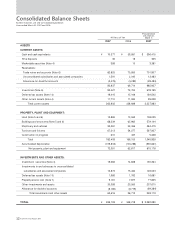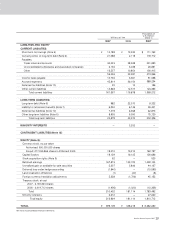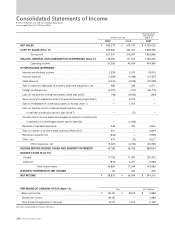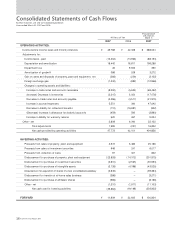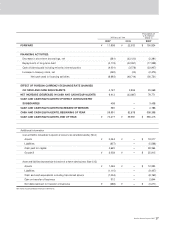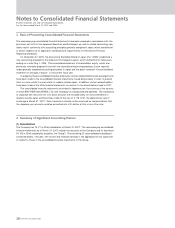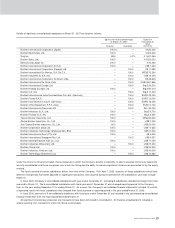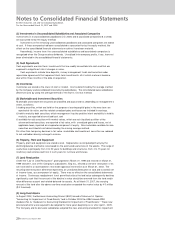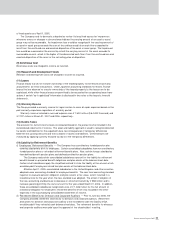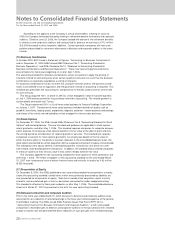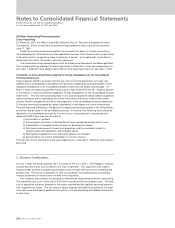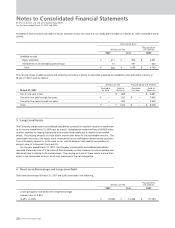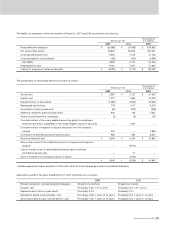Brother International 2007 Annual Report Download - page 22
Download and view the complete annual report
Please find page 22 of the 2007 Brother International annual report below. You can navigate through the pages in the report by either clicking on the pages listed below, or by using the keyword search tool below to find specific information within the annual report.
20 Brother Annual Report 2007
Notes to Consolidated Financial Statements
Brother Industries, Ltd. and Consolidated Subsidiaries
For the Years ended March 31, 2007 and 2006
(2) Investments in Unconsolidated Subsidiaries and Associated Companies
Investments in 2 unconsolidated subsidiaries (3 in 2006) and 6 associated companies (6 in 2006)
are accounted for by the equity method.
Investments in the remaining unconsolidated subsidiaries and associated companies are stated
at cost. If these companies had been consolidated or accounted for by the equity method, the
effect on the consolidated financial statements w ould not have been material.
Accordingly, income from the unconsolidated subsidiaries and associated companies is
recognized w hen the Group receives dividends. Unrealized inter-company profits, if any, have not
been eliminated in the consolidated financial statements.
(3) Cash Equivalents
Cash equivalents are short-term investments that are readily convertible into cash and that are
exposed to insignificant risk of changes in value.
Cash equivalents include time deposits, money management funds and securities under
repurchase agreements that represent short-term investments, all of w hich mature or become
due w ithin three months of the date of acquisition.
(4) Inventories
Inventories are stated at the low er of cost or market. Cost is determined by the average method
by the Company and consolidated manufacturing subsidiaries. The consolidated sales subsidiaries
determine cost by using the average method or the first-in, first-out method.
(5) Marketable and Investment Securities
Marketable and investment securities are classified and accounted for, depending on management's
intent, as follows:
i) trading securities, w hich are held for the purpose of earning capital gains in the near term are
reported at fair value, and the related unrealized gains and losses are included in earnings,
ii) held-to-maturity debt securities, which management has the positive intent and ability to hold to
maturity, are reported at amortized cost, and
iii) available-for-sale securities with market values, w hich are not classified as either of the
aforementioned securities, are reported at fair value, w ith unrealized gains and losses, net of
applicable taxes, reported as a separate component of equity. Non-marketable available-for-sale
securities are stated at cost determined by the moving average method.
For other than temporary declines in fair value, marketable and investment securities are reduced
to net realizable value by a charge to income.
(6) Property, Plant and Equipment
Property, plant and equipment are stated at cost. Depreciation is computed primarily by the
declining-balance method at rates based on the estimated useful lives of the assets. The range of
useful lives is principally from 3 to 50 years for buildings and structures, from 4 to 15 years for
machinery and vehicles and from 2 to 20 years for furniture and fixtures.
(7) Land Revaluation
Under the "Law of Land Revaluation", promulgated on M arch 31, 1998 and revised on M arch 31,
1999 and 2001, one of the Company's subsidiaries, Xing Inc., elected a one-time revaluation of its
ow n-use land to a value based on real estate appraisal information as of M arch 31, 2002. The
resulting land revaluation difference represents an unrealized devaluation of land and is stated, net
of income taxes, as a component of equity. There was no effect on the consolidated statements
of income. Continuous readjustment is not permitted unless the land value subsequently declines
significantly such that the amount of the decline in value should be removed from the land revalu-
ation difference account and related deferred tax assets. As at March 31, 2007, the carrying
amount of the land after the above one-time revaluation exceeded the market value by ¥ 0 million
($ 0 thousand).
(8) Long-lived Assets
In August 2002, the Business Accounting Council (BAC) issued a Statement of Opinion,
"Accounting for Impairment of Fixed Assets," and in October 2003 the ASBJ issued ASBJ
Guidance No. 6, "Guidance for Accounting Standard for Impairment of Fixed Assets." These new
pronouncements w ere required to be adopted for fiscal years beginning on or after April 1, 2005.
The Company and its domestic subsidiaries adopted the new accounting standard for impairment




